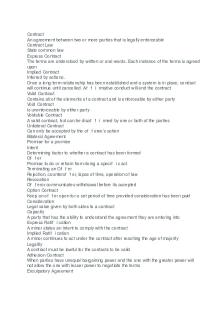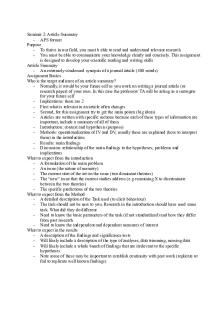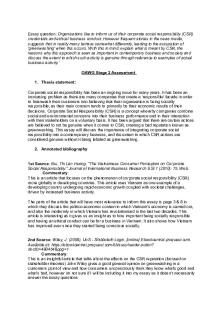Misuse of drugs 2 - Lecture notes 2 PDF

| Title | Misuse of drugs 2 - Lecture notes 2 |
|---|---|
| Course | Drugs of Abuse |
| Institution | Keele University |
| Pages | 5 |
| File Size | 62.7 KB |
| File Type | |
| Total Downloads | 23 |
| Total Views | 153 |
Summary
Abuse and misuse of drugs. Classification of controlled drugs, Classification under Misuse of Drugs Regulations 2001, Controls under MoD Regulations 2001, Controlled drug register....
Description
Misuse of drugs 2 Abuse – Deliberately using the drug outside of its licence to achieve an inappropriate aim. Misuse - Use of the drug in an inappropriate, but perhaps well-intentioned way. o Higher than recommended dose o Longer than recommended treatment used Regulations of drugs of misuse – Misuse of Drugs Act 1971 Misuse of Drugs Regulations 2001 Misuse of Drugs Act 1971 – Primary purpose is to prevent the misuse of controlled drugs. Achieves this by imposing a total prohibition on the possession, supply, manufacture, import/export of controlled drugs except : o As allowed by the Misuse of Drugs Regulations 2001 OR o Under a Home Office license issued by the Secretary of State Consolidated & extended previous legislation surrounding dangerous/harmful drugs (Controlled Drugs – CD). Designed to deal with the control & treatment of addiction & promote education & research relating to drug dependence. Objectives of the Act – Control of misuse Categorise drugs Control of trading & production Control of possession & trafficking Surveillance Flexibility of approach Education, treatment & rehabilitation Control of prescribing & supply Advisory Council on the Misuse of Drugs (ACMD) – Make recommendations to Government on control of dangerous drugs (classification & schedule). Keeps under review the situation in UK & advises the relevant Ministers on matters like o
Restrict availability of such drugs/supervise arrangements for their supply Enable people affected by the misuse of drugs to obtain proper advice
Secure the provision of facilities & services for their treatment, rehabilitation & aftercare.
Promotes co-operation between the professional & community services which deal with social problems. Educate the public (especially the young) in the dangers of drug misuse. Promote research into drug misuse, its prevention/ social problems of drug misuse.
Classification of controlled drugs – 2 methods – 1. Under Misuse of Drugs Act 1971 o Classified according to potential for harm o Classified in classes
2. Under Misuse of Drugs Regulations 2001 o Classified according to their use in medicine & potential for misuse o Classified in schedules Classification under MoD Act 1971 – Substances classified under the Act are known as controlled substances. Classified on basis of decreasing order of harmfulness Classification solely for the purpose of determining penalties 3 classes (A, B & C) Class Class Class
A– Heroin, morphine, LSD & ecstasy B– Amphetamines (non-injectable) & cannabis C– Benzodiazepines, ketamine
Reclassification of cannabis – Moved from Class B to C (2004) then back to B in 2008. Changing classification has impacted on the maximum penalty for possession & supply as a consequence of the changes. Offences under MoD Act 1971 – Possession of a controlled substance unlawfully. Possession of a controlled substance with intent to supply (unlawfully). Trafficking – unlawful supply of a controlled drug o Includes where no charge is made for the drug Allows premises you occupy/manage to be used for the purpose of smoking cannabis/opium. Maximum penalties under MoD Act 1971 - ** Penalties relating to cannabis – Possession (adults) o Most offences result in a warning & confiscation of the drug. o If there are aggravating factors (smoking in a public place/repeat offending – arrest & prosecution) Possession (young people under 18) – o 1st offence – arrest & formal warning/reprimand o Further offences – final warning/charge.
Possession for research purposes – Small quantities of CDs can be used for research provided they are in nonrecoverable form & not for human consumption. Home Office Schedule 1 licenses required to possess CDs. Currently under review – letter from ACMD to Victoria Atkins MP in further reading. Classification under Misuse of Drugs Regulations 2001 – SCH 1 – not used for medicinal purposes SCH 2 – opiates & stimulants
SCH 3 – Barbiturates & minor stimulants SCH 4 – o PART 1 - Benzodiazepines o PART 2 – Anabolic/androgenic steroids & polypeptide hormones SCH 5 – negligible risk / low strength Controls under MoD Regulations 2001 – Import & export Possession & supply Administration Hospitals & nursing homes Midwives Controlled drugs under Patient Group Direction Patients and their representatives SCH 1
(CD Lic) – Most strictly controlled group Use limited to research & other special purposes Little / no medicinal use License needed from Home Office to possess, produce & supply (E.G. LSD, weed) Cannabis – 1st November 2018, Home Office amended the MoD Regulations 2001 to move cannabis-based products for medicinal use from SCH 1 →SCH 2 Specialist prescribers now able to prescribe products under the prescribing rules for SCH 2 CDs. o Exception is Sativex, SCH 4 with caveats SCH 2 (CD) – Full controls relating to – o Prescription requirements o Handwriting requirements o Safe custody Full records required Licenses required for import/export E.G. morphine, fentanyl, diamorphine, oxycodone, amphetamines, CBD products
SCH 3 (CD No Reg) – Controls not as stringent as for SCH 2 . o Safe custody requirements apply but exemptions exist (phenobarbital, pregabalin, gabapentin & tramadol. Records required but CD register entry not required. Invoices must be retained for 2 years. Licenses required for import/export. o Buprenorphine, gabapentin, pregabalin, tramadol & temazepam. SCH 4 (CD Anab/CD Benz) – SCH split into 2 parts: o CD Anab – Anabolic steroids & growth hormones o CD Benz – most benzodiazepines (diazepam) No safe custody, prescription/handwriting requirements/records to be kept. License needed for import/export.
SCH 5 (CD Inv) – Low strength preparations of certain controlled substances o Does not include preparations for injection o (morphine sulphate (anamorph) 10mg/5ml Oral solution) o Above 13mg/5ml Morphine remains SCH 2 May be POM / P medicines Invoices must be retained for 2 years Negligible risk of abuse (in practice are frequently abused) Prescriptions for CDs – Prescriptions for SCH 1 to 4 CDs are valid for 28 days from the appropriate date. Legal requirement to include details of what to prescribe including dosage instructions. Prescriptions for SCH 2 & 3 CDs must state the quantity in words & figures. Medicinal use of cannabis – Sativex (Nabiximols)- derived from cannabis & licensed for use in UK for management of multiple sclerosis. Classified as SCH 4 Part 1 controlled drug but has record requirements of a SCH 2. Application of CD regulations – Possession Requisitions Record keeping Storage Destruction
Persons who may possess CDs (P1)– Holding a Home Office license Police & Customs Officers Couriers & Post Office employees Person engaged in the word of a forensic lab Public analyst/sampler working under the Food & Drugs Act 1955 Practitioner (doctor/dentist/vet) P2 Registered midwives Pharmacist/pharmacy owners Matrons/sisters in charge of a hospital/nursing home/ward Person in charge of a lab used for scientific education/research Owner/master of a British ship o Where there is no doctor employed on board P3 – Master of a foreign ship in GB port Installation manager of an offshore installation Person possessing a drug for administration in accordance with the directions of a practitioner (substance misuse patients) Person licensed under the Wildlife & Countryside Act 1981
Requisition requirements for CDs – Be signed by the recipient (person authorised for supply) State name & address, with profession/occupation Specify total quantity of drug & purpose for which it is required Supplier must be satisfied that the signature & quantification are genuine Controlled drug register – Entries must be in ink, in date order & made within 1 day. Register must be kept at the premises at all times & for 2 years from the last date entry. Register, documents & stock of drugs must be available for inspection. Pharmacists must check the ID of people collecting CDs (especially professionals) Running balance must be kept Controlled drug register ** Storage of CDs – SCH 1, 2 & some 3 CDs must be stored in a cabinet built to the specification set out in the MoD Regulations 2001. The pharmacist can obtain police consent to use the pharmacy safe. SCH 3 required storage are Diethylpropion, Temazepam & Buprenorphine Destruction of CDs – Stock of SCH 1 & 2 is only permitted in the presence of an appropriate person. Safe and appropriate disposal is required. Must comply with disposal of waste regulations & other environmental protection rules...
Similar Free PDFs

2 - Lecture notes 2
- 5 Pages

Use of Force 2 - Lecture notes 2
- 3 Pages

Act-1986-036 - drugs misuse act
- 133 Pages

Misuse of Private information
- 8 Pages

Drugs online quiz 2
- 37 Pages

Lecture notes, lecture 2
- 3 Pages

2 Biodiversity - Lecture notes 2
- 33 Pages

Chapter 2 - Lecture notes 2
- 30 Pages

Blaw 2 - Lecture notes 2
- 4 Pages

Chapter 2 - Lecture notes 2
- 4 Pages

Seminar 2 - Lecture notes 2
- 2 Pages

Stage 2 - Lecture notes 2
- 3 Pages

Micro 2 - Lecture notes 2
- 18 Pages

2 Sources - Lecture notes 2
- 4 Pages

Prof 2 - Lecture notes 2
- 3 Pages
Popular Institutions
- Tinajero National High School - Annex
- Politeknik Caltex Riau
- Yokohama City University
- SGT University
- University of Al-Qadisiyah
- Divine Word College of Vigan
- Techniek College Rotterdam
- Universidade de Santiago
- Universiti Teknologi MARA Cawangan Johor Kampus Pasir Gudang
- Poltekkes Kemenkes Yogyakarta
- Baguio City National High School
- Colegio san marcos
- preparatoria uno
- Centro de Bachillerato Tecnológico Industrial y de Servicios No. 107
- Dalian Maritime University
- Quang Trung Secondary School
- Colegio Tecnológico en Informática
- Corporación Regional de Educación Superior
- Grupo CEDVA
- Dar Al Uloom University
- Centro de Estudios Preuniversitarios de la Universidad Nacional de Ingeniería
- 上智大学
- Aakash International School, Nuna Majara
- San Felipe Neri Catholic School
- Kang Chiao International School - New Taipei City
- Misamis Occidental National High School
- Institución Educativa Escuela Normal Juan Ladrilleros
- Kolehiyo ng Pantukan
- Batanes State College
- Instituto Continental
- Sekolah Menengah Kejuruan Kesehatan Kaltara (Tarakan)
- Colegio de La Inmaculada Concepcion - Cebu
